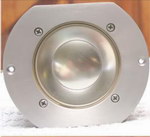
Originally Posted by
RMC

Hi Ivica,
I DID mention in my post # 11 "The former example shows nice extended response but a LOT of beaming at 4khz and 8khz on polar response curves." So there is no disagreement on response issue. I always try to be faithful to reality/facts. I don't doubt you are very satisfied on response. Also, staying in the JBL family isn't a bad idea in itself, as long as it makes technical sense, which doesn't seem appropriate here with bi-radial horns in my view for the reasons mentioned before and here below.
As for coverage of Bi-radial horns, I can't say it better than THE MAN himself, so here it is: "The typical directional properties of such a horn are shown at B. Note, as in the case of the multi-cellular horn, that there is mid-range narrowing in the horizontal direction at the frequency whose wavelength is equal to the mouth width. Further, because the vertical cross-section of the radial horn is exponential, the vertical response narrows progressively with frequency over the entire range." John Eargle (JBL), Handbook of Sound system Design, ELAR, 1989, P. 76. See also John Eargle (JBL), Loudspeaker Handbook, Chapman & Hall, 1997, P. 149-152 for similar conclusions, with a bit more nuance re exact frequency where this happens.
"If talking the horizontal dispersion I wonder what would be the dispersion of the desired mid-rage drivers while reaching over 5~6kHz". The 104h2 nominal and effective horizontal dispersion patterns would NOT be affected if used single nor with double 104h2 if placed vertically one above the other. I think I've quoted enough experts on this, refer to previous posts.
The 104h2 expected crossover frequencies for Glenn's project are 800 hz and 4.5 khz (proven recipe) as in JBL's 4410, 4412, L100T and L100T3 (not really used "over 5-6 khz" as you mention). A tweeter would take over from 4.5 khz with better dispersion than a nominal 60° X 40° bi-radial horn.
Glenn has many (9) unused 104h2 midranges drivers, and 2204H woofers. I'm just trying to help him make something wisely so it flies decently, and with reasonable or minimal costs and waste of drivers. Regards,
Richard



 Reply With Quote
Reply With Quote


